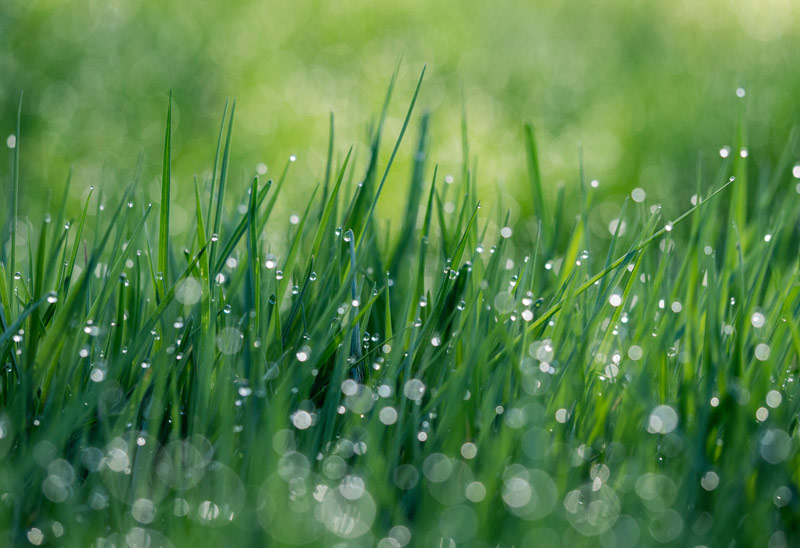
Buffering the plant against temperature fluctuations, maintaining plant structure and facilitating photosynthesis are among the roles water plays in a single blade of turfgrass. Photo by Aaron Burden/Unsplash
Editor’s note: A version of this article first appeared in Tennessee Turfgrass, the official publication of the Tennessee Turfgrass Association.
It is estimated that water makes up about 71% of the Earth’s surface and that 96.5% of all the Earth’s water is salt water contained in the oceans. Only an estimated 3.5% is fresh water, 69% of which occurs as ice in glaciers and ice caps. Slightly more than 0.7%, or 8.6 million acre-feet, of the Earth’s fresh water occurs as groundwater and in rivers, lakes and streams.
What follows is a summary of how this valuable resource functions and flows within turfgrass, making recreational surfaces and the other functional, environmental and aesthetic benefits of turfgrass possible.
How water functions in turf
Water is essential for seed germination and plant growth, and it usually makes up 75% or more of the fresh weight of actively growing turfgrasses. Roots contain the least amount of water, and stems the most.
Water moves by way of diffusion from the soil solution into root hairs. Once inside turfgrass plants, water helps protect them from sudden changes in temperature.
Both organic and inorganic molecules, including sugars and essential mineral nutrients, move to plant cells in water. An estimated 1% to 3% of the total amount of water taken up by turfgrasses every day is required to support internal biochemical reactions in plant cells as well as cell division and expansion.
Although this amount may appear small compared with the total amount of water turfgrasses use, it is vitally important for plant survival. Without water, turfgrasses would not be able to convert sunlight into chemical energy by way of photosynthesis (6 CO2 + 6 H2O → C6H12O6 + 6 O2). Warm-season turfgrasses have a more efficient photosynthetic system than cool-season turfgrasses do. Cool-season turfgrasses need about three times more water than warm-season turfgrasses to produce equal amounts of shoot and root tissue. As much as 600 pounds of water may be necessary to produce 1 pound of turfgrass dry matter.
The uptake of water is crucial for maintaining cell turgidity and tissue turgor pressure. Turgor pressure is pressure exerted by the fluid within a plant cell, pushing the cell membrane against the cell wall, and it plays a key role in processes such as growth, development and stress response. Water uptake is also essential to turf’s ability to tolerate wear and recover from the compressive forces of foot and equipment traffic. Water is the source of the pressure responsible for the unfolding of leaves, the opening of stomates, and the movement of roots and rhizomes in soils.
How water flows in turf
Absorption
Soil
The oxygen level in soil pore spaces generally ranges from 0% to 21%, while the level of carbon dioxide usually ranges from 0.03% to 20% or more. The water vapor content in soils may exceed 80%. A small amount of oxygen is dissolved in rain or irrigation water. Air is also drawn downward as water moves vertically through the soil profile.
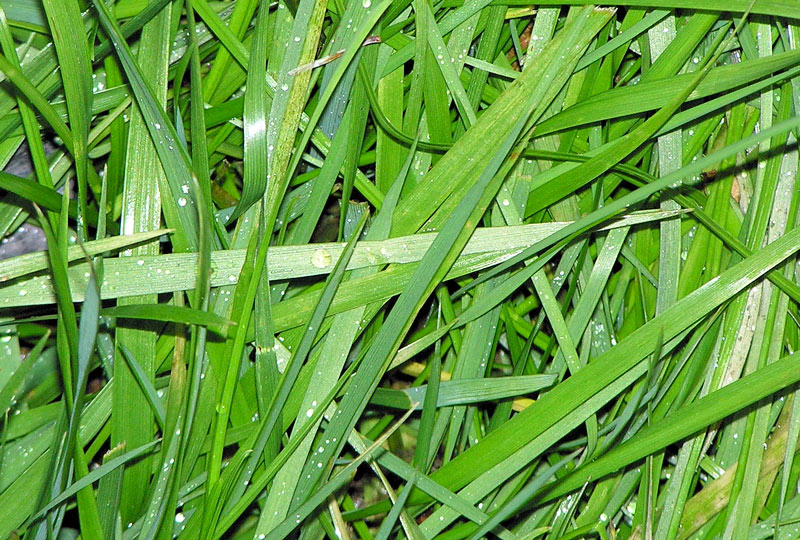
Rain-spattered tall fescue. Photo courtesy of Tom Samples
As turfgrasses grow, the transfer of water within and among the soil, the plant and the atmosphere is continuous. Most water absorption from soil takes place in the root hair zone just behind the root apex. The presence of root hairs increases the absorptive surface of the plant’s root system. The length of the root hair zone varies among turfgrass species, and it is affected by the age of the roots and the environmental conditions during root development. Root hairs live for only a few weeks before being replaced as roots expand and mature. Root hair numbers decrease with increasing soil moisture.
The amount of soil water absorbed by turfgrasses is influenced by rooting depth and root number; root extension rate; the amount of plant-available water; transpiration rate; and soil temperature. Water is first absorbed at a shallow level and then at successively greater depths as the water supply is depleted. Some water absorption and translocation can occur through a lifeless root system.
Foliage
Water in either liquid or vapor form and in some foliar-applied nutrients enters aerial shoots of turfgrasses through tiny (less than 1 nanometer in diameter) cracks or transcuticular pores. The absorption of water from leaf and stem surfaces does not generally occur by way of a series of openings, the stomates, in part because of the presence of waxes. Foliar water absorption is usually more rapid in young rather than old leaves. The size of water droplets may range from 50 (fog) to 500 (extremely coarse) microns. The amount of water absorbed by foliage under “normal” growing conditions is only a minor portion of the total amount of water absorbed by turfgrass plants.
Evapotranspiration
Evapotranspiration, or ET, is the process by which water is transferred from plants and their surfaces to the atmosphere. It consists of two actions: evaporation and transpiration. Evaporation is the physical process resulting in a change of water on a plant surface from liquid to vapor. Transpiration is the plant process during which water is evaporated through the stomates, which are pores on the epidermis of leaves and stems that open and close to control the rate of gas exchange. The amount of water lost by evaporation from the surface of plants is minimal compared with that lost by transpiration. The conversion of liquid water to water vapor requires 570 calories per gram of water (~259,000 calories per pound). Given that energy is consumed as water in liquid form vaporizes, evapotranspiration produces a cooling effect.
Editor’s note: Follow the authors and other University of Tennessee turfgrass scientists on Twitter at @UTturfgrass for information on timely turf topics, the latest research on weed control in turf, and continuing education opportunities.
Environmental conditions — including soil moisture, wind, sunlight (radiant energy), relative humidity (atmospheric vapor pressure) and temperature — affect the rate at which moisture is lost from turf surfaces. The rate of ET is usually low during dark, cloudy days with high relative humidity, low air temperature and very little wind. Highest ET rates occur on hot, sunny days with low relative humidity and moderate to high winds.
Fans may be positioned around the perimeter of golf course greens located in areas with restricted airflow. Golf course superintendents may activate the fans and/or routinely syringe in an effort to cool air and soil temperatures and limit bentgrass stress during summer months. Under certain environmental conditions, the application of a light film of water on aerial shoots (syringing) may result in a cooling effect as water absorbs the heat energy necessary to change from liquid form to vapor. A two-year study conducted at Auburn University revealed that, when temperatures were 90 degrees F or higher, the combination of fans and syringing reduced air and soil temperatures, although plant rooting depth did not significantly increase (3).
Transpiration
Transpiration is the release of water (evaporation) from leaves. A few definitions will be helpful for this discussion:
- Mesophyll cells make up most of the interior of the leaf between the upper and lower epidermal layers. These cells are relatively large and have vacuoles and many chloroplasts. As a result, they are specialized for photosynthesis.
- Root epidermal cells are very close and interlock, forming a layer that serves as a boundary between the plant root and the soil’s “environment.” One major role of the root epidermis is the absorption of water and mineral nutrients from the soil.
Stomatal transpiration
Depending on turfgrass species, the stomatal density most often ranges from 1,000 to 6,000 per square centimeter (about 155 to 930 per square inch) on the lower leaf surface, and from 4,000 to 10,000 per square centimeter (about 620 to 1,550 per square inch) on the upper surface. Although stomates make up only 2% to 3% of the total leaf area, they are often responsible for as much as 90% of the total water lost to the atmosphere by transpiration. The exchange of oxygen and carbon dioxide occurs through open stomates.
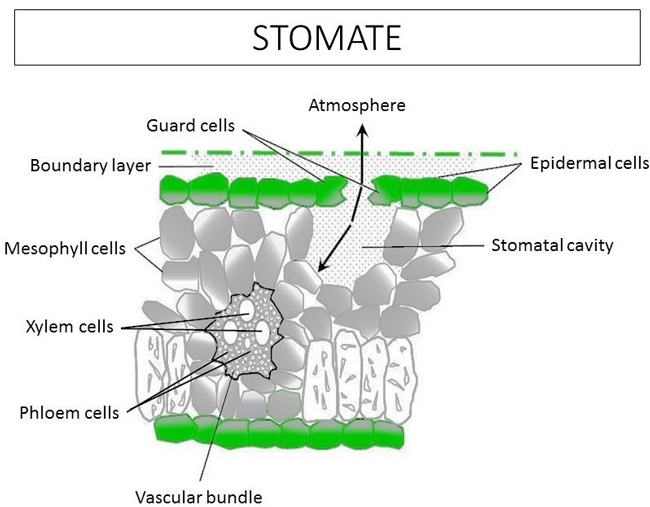
In stomatal transpiration, water evaporates from the moist surfaces of mesophyll cells. Water vapor then moves into intercellular spaces before diffusing along a vapor pressure gradient through the intercellular spaces into the stomatal cavity and eventually to the atmosphere. The extent of this vapor pressure gradient is often used to predict the evaporation rate from turfgrasses to the atmosphere, with more evaporation occurring at high air temperatures and low levels of relative humidity.
The stomatal transpiration rate is a function of the vapor pressure gradient. A portion of the water being transported from root epidermal cells to mesophyll cells of the stomates is diverted from the main transpirational stream to several types of specialized tissues depending on where the water potential gradient exists.
Xylem
Xylem is nonliving conductive tissue responsible for the movement of water and essential mineral nutrients from roots up to rhizomes, stolons, tillers and leaves. Xylem is continuous from the root hair zone of the roots through the mesophyll cells of the leaves.
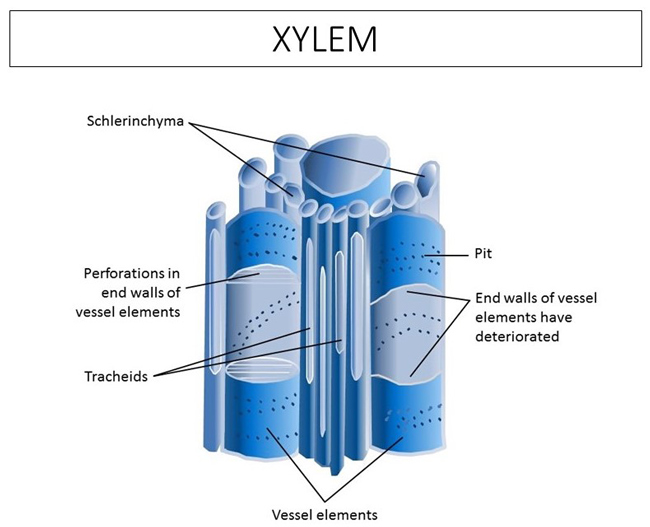
Water enters root hairs by osmosis and moves in xylem, diffusing through cross walls that may or may not be perforated. Eventually, much of the water moves from leaves to the atmosphere through stomates as water vapor. A hydrostatic gradient develops between the evaporation zone of leaves and the water absorption region of roots. Water evaporation results in a decrease in the water potential of the mesophyll cells. This causes water in xylem to move toward the mesophyll cells. This “siphoning” by which water in liquid form is pulled from an area where it is most plentiful to an area where it is less plentiful is referred to as transpiration “pull.” Transpiration pull causes water to diffuse from adjacent root cells into the lower regions of the xylem.
Cuticular transpiration
Although the majority of transpirational water loss occurs through stomates, some is lost by evaporation through the cuticle of epidermal cells while stomates are closed. The cuticle serves as a protective film covering and consists of polymers of both lipids and hydrocarbons containing wax.
The thickness of the cuticular layer has a major impact on the amount of cuticular transpiration. Although cuticle width is largely controlled by genetics and varies among turfgrass species, research indicates that the plant cuticle is responsive to leaf age and environmental changes. For example, the mass of the cuticle and the amount of wax generally increase as leaf age increases, and shade results in a reduction in cuticle thickness.
Vascular bundles
Vascular bundles are long strands of vascular tissue in leaves, stems and roots that contain xylem, phloem (more on phloem below) and supporting cells. The vascular bundles of the turfgrass leaf contain the same type of xylem and phloem structure as those of the stem. Most of the veins of a turfgrass leaf blade are made up of a single vascular bundle, while the leaf midrib may contain several vascular bundles. The arrangement of xylem and phloem elements in large veins resembles their arrangement in the stem.
Phloem
Part of vascular bundles, phloem is living tissue that transports soluble organic compounds made during photosynthesis, namely sugars, to where they’re needed in the plant. Some water in turfgrasses is used by the phloem tissue to transport sugar in both upward (acropetal) and downward (basipetal) directions.
Phloem contains companion cells and sieve tubes. Glucose, sucrose and fructose move from “source” cells into companion cells, which are directly adjacent to phloem sieve tubes. The movement of sugars into sieve tubes reduces the water potential, and water is taken up from the xylem by osmosis, raising the pressure potential in the sieve tube. The differences in internal pressure drive the phloem sap along the sieve tube to “sink” cells. As sugars move into sink cells, the water potential in the sieve tube increases, and water moves by osmosis back into the xylem.
Water forms
Snow
In addition to buffering turfgrasses from low temperature extremes and dehydration, a layer of snow also limits freezing and thawing of soils and soil heaving. Turfgrass plants may be lifted and roots exposed as soils heave.
Dew
Dew forms when the turf surface cools as a result of the loss of infrared radiation to a temperature lower than the dew point of the surrounding air. The relative humidity is 100% when the dew point and the temperature are the same. If the temperature drops any lower, condensation will result, and water droplets will form. Dragging a hose over bentgrass turf on golf greens in the morning to remove dew is a cultural practice intended to help prevent dollar spot (Clarireedia spp.), but it can spread the disease if fungi are active.
Guttation fluid
Under certain environmental conditions, water containing plant exudates (guttation fluid) may move through very small openings called “hydathodes” located at the ends of uncut leaves. These exudates contain mineral salts, sugars, amino acids and other organic compounds.
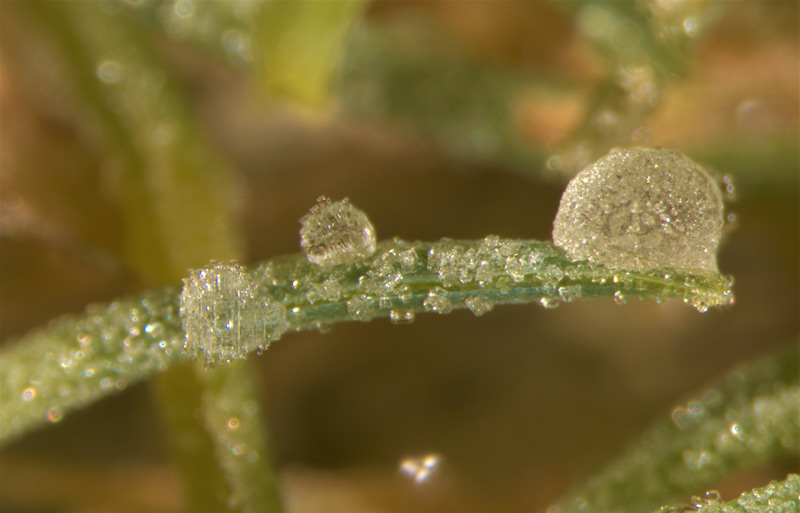
Frozen guttation fluid on bentgrass. Photo courtesy of Alan Windham
Drops of guttation fluid may also be the direct result of exudation from freshly cut leaves. Exudation usually occurs when environmental conditions cause rapid water absorption by roots and, at the same time, restrict transpiration. These conditions produce a rise in root pressure and an elevated turgor pressure at the leaf tip.
Leaf exudation occurs most often during the night or early morning hours and is promoted by routine irrigation, high nitrogen fertility and close, frequent mowing. Warm days followed by cool nights also favor leaf exudation. Tip burn of leaves from a high solute concentration may be visible when droplets of guttation water evaporate or are reabsorbed by the leaf.
References
- Beard, J.B. 1973. Water (chapter 8). In: Turfgrass: Science and culture. Prentice Hall, Englewood Cliffs, N.J.
- Turgeon, A.J. 1999. The turfgrass environment (chapter 4). In: Turfgrass Management, Fifth Edition. Prentice Hall, Upper Saddle River, N.J.
- Guertal, E.A., E. van Stanten and D.Y. Han. 2005. Fan and syringe application for cooling bentgrass greens. Crop Science 45(1):245-250.
Tom Samples is a professor and turfgrass science Extension specialist at the University of Tennessee, Knoxville, Tenn. John Sorochan is a distinguished professor of turfgrass science at the University of Tennessee, Knoxville, Tenn. Alan Windham is a professor and University of Tennessee plant pathology Extension specialist whose focus includes the diagnosis and management of diseases of turfgrass and ornamental plants, mycology, microscopy, and macrophotography. He is based at the University of Tennessee Soil, Plant and Pest Center, Nashville, Tenn.